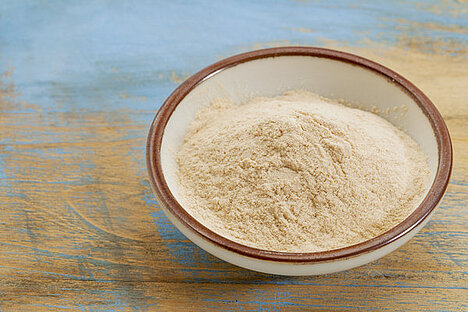Phosphorus

But how much phosphorus does your dog need and what should you pay attention to when feeding it? In this article, you will learn everything you need to know about phosphorus in dog food.
The right ratio of phosphorus and calcium
Phosphorus and calcium interact closely with each other. Too high or too low an intake of one of the two minerals can disturb the balance and lead to health problems.
Too much phosphorus can inhibit calcium absorption and lead to hyperacidity of the blood. This can put a strain on the kidneys and lead to kidney stones or kidney failure. Too little phosphorus can weaken bones and teeth and impair nerve and muscle function.
To avoid this, you should make sure that your dog gets a balanced ratio of phosphorus and calcium. The optimum ratio is between 1.2:1 and 1.3:1, i.e. 1 gram of phosphorus for every 1.2 to 1.3 grams of calcium.
Most commercial dog foods contain sufficient phosphorus and calcium in an appropriate ratio. You can read this on the packaging or ask the manufacturer. If you feed your dog cooked or raw food yourself, you must ensure that you use enough phosphorus- and calcium-rich foods.
Phosphorus-rich foods for dogs
Phosphorus is found in many animal and plant foods.
Particularly rich in phosphorus are:
- Meat (especially offal such as liver, kidney or heart)
- Fish (especially sea fish such as salmon, mackerel or sardines)
- eggs
- Dairy products (especially cheese)
- nuts
- Legumes
- cereals
Calcium-rich foods for dogs are
- Bones (especially soft bones such as chicken necks or beef ribs)
- Egg shells
- Dairy products (especially curd cheese or yoghurt)
- Green leafy vegetables (especially broccoli or kale)
If you feed your dog these foods in a balanced ratio, he should get enough phosphorus and calcium. You can also use special supplements that contain both minerals, but only after consulting your vet.
Low phosphorus diet for kidney problems
If your dog suffers from chronic renal insufficiency, it must be fed a diet low in phosphorus. This is because when kidney function is impaired, excess phosphorus can no longer be excreted and accumulates in the blood. This can lead to further damage to the kidneys and other organs.
A low-phosphorus diet means that you feed your dog food with a low phosphorus content. This includes:
- Muscle meat (especially poultry or horse)
- rice
- potatoes
- carrots
- apples
- bananas
You should not feed your dog bones, offal, fish, eggs, dairy products, nuts, pulses or cereals, as these contain a lot of phosphorus. You can also buy special diet food for dogs with kidney disease, which has a low phosphorus content.
In addition, you should always provide your dog with plenty of fresh water so that he can flush his kidneys. Your vet can also prescribe medication that promotes phosphorus excretion or inhibits phosphorus absorption.
Phosphorus is an important mineral for your dog which, together with calcium, ensures strong bones and teeth. You should make sure that your dog gets a balanced ratio of phosphorus and calcium that is between 1.2:1 and 1.3:1. Most dog foods offer this, but you can also feed home-cooked or raw food with phosphorus and calcium-rich foods.
If your dog suffers from renal insufficiency, he needs to be fed a low-phosphorus diet to protect his kidneys. To do this, you should feed him food with a low phosphorus content or buy special diet food.
Properties 2
Are you looking for other ingredients with a specific property?
Just click on them to find more.
If you notice any signs of hypersensitivity or poisoning in your dog, you should see your vet immediately. We are not a substitute for a vet, but we try to be as accurate as possible. Every dog reacts differently and we recommend you get a second opinion or consult your vet if in doubt.
Stay healthy and take good care of your four-legged friend!😊